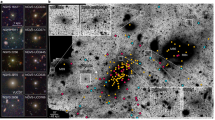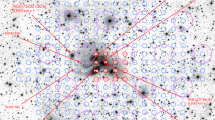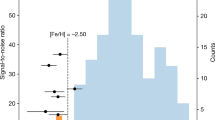Abstract
In many gravitational interactions between galaxies, gas and stars that have been torn from the precursor galaxies can collect in tidal ‘tails’. Star formation begins anew in some of these regions, producing tidal dwarf galaxies1,2,3,4. Observations of these new galaxies provides insight into processes relevant to galaxy formation more generally, because the timescale of the interaction is well defined. But tracking the star formation process has hitherto been difficult because the tidal dwarf galaxies with young stars showed no evidence of the molecular gas out of which those young stars formed5,6,7,8. Here we report the discovery of molecular hydrogen (traced by carbon monoxide emission) in two tidal dwarf galaxies. In both cases, the concentration of molecular gas peaks at the same location as the maximum in atomic-hydrogen density, unlike the situation in most gas-rich galaxies. We infer from this that the molecular gas formed from the atomic hydrogen, rather than being torn in molecular form from the interacting galaxies. Star formation in the tidal dwarf galaxies therefore appears to mimic the process in normal spiral galaxies like our own.
This is a preview of subscription content, access via your institution
Access options
Subscribe to this journal
Receive 51 print issues and online access
$199.00 per year
only $3.90 per issue
Buy this article
- Purchase on Springer Link
- Instant access to full article PDF
Prices may be subject to local taxes which are calculated during checkout



Similar content being viewed by others
References
Mirabel, I. F., Dottori, H. & Lutz, D. Genesis of a dwarf galaxy from the debris of the Antennae. Astron. Astrophys. 256, L19– L23 (1992).
Duc, P.-A. & Mirabel, I. F. Recycled galaxies in the colliding system Arp 105. Astron. Astrophys. 289, 83–93 (1994).
Duc, P.-A., Brinks, E., Wink, J. E. & Mirabel, I. F. Gas segregation in the interacting system Arp 105. Astron. Astrophys. 326, 537–553 (1997).
Duc, P.-A. & Mirabel, I. G. Young tidal dwarf galaxies around the gas-rich disturbed lenticular NGC 5291. Astron. Astrophys. 333, 813–826 ( 1998).
Brouillet, N., Henkel, C. & Baudry, A. Detection of an intergalactic molecular complex? Astron. Astrophys. 262, L5–L8 (1992).
Walter, F. & Heithausen, A. The discovery of a molecular complex in the tidal arms near NGC 3077. Astrophys. J. 519, L69–L72 (1999).
Smith, B. J. & Higdon, J. L. A search for CO(1–0) emission from the tidal structures of interacting and merging galaxies. Astron. J. 108, 837–843 (1994).
Smith, B. J., Struck, C., Kenney, J. D. P. & Jogee, S. The molecule-rich tail of the peculiar galaxy NGC 2782 (Arp 215). Astron. J. 117, 1237–1248 (1999).
Zwicky, F. Multiple galaxies. Ergenisse Exakten Naturwissenschaften 29, 344–385 (1956).
Schweizer, F. in Structure and Properties of Nearby Galaxies (eds Berkhuijsen, E. M. & Wielebinski, R.) 279–284 (Riedel, Dordrecht, 1978).
Hibbard, J. E. & van Gorkom, J. H. HI, HII, and R-Band observations of a galactic merger sequence. Astron. J. 111, 655–695 ( 1996).
Duc, P.-A. & Mirabel, I. F. in Galaxy Interactions at Low and High Redshift (eds Barnes, J. & Sanders, D.) 61– 70 (IAU Symp. 186, Kluwer, Dordrecht, 1997).
Barnes, J. E. & Hernquist, L. Formation of dwarf galaxies in tidal tails. Nature 360, 715– 717 (1992).
Duc, P.-A. et al. The interacting system NGC 2992/3 (Arp 245). Astron. J. (submitted).
Taylor, C. L., Kobulnicky, H. A. & Skillman, E. D. CO emission in low-luminosity, HI-rich galaxies. Astron. J. 116, 2746–2756 (1998).
Kennicutt, R. C. Jr Star formation in galaxies along the Hubble sequence. Annu. Rev. Astron. Astrophys. 36, 189– 232 (1998).
Guélin, M. et al. 1.3 mm emission in the disk of NGC 891: Evidence of cold dust. Astron. Astrophys. 279, L37– L40 (1993).
Braine, J., Combes, F. & Van Driel, W. NGC 4414: A flocculent galaxy with a high gas surface density. Astron. Astrophys. 280, 451– 467 (1993).
Hollenbach, D. & MCKee, C. F. Molecule formation and infrared emission in fast interstellar shocks. III—results for J shocks in molecular clouds. Astrophys. J. 342, 306–336 (1989).
Neininger, N., Guélin, M., Garcia-Burillo, S., Zylka, R. & Wielebinski, R. Cold dust and molecular line emission in NGC 4565. Astron. Astrophys. 310, 725–736 (1996).
Dumke, M. et al. the interstellar medium in the edge-on galaxy NGC 5907. Cold dust and molecular line emission. Astron. Astrohys. 325, 124–134 (1997).
Braine, J. et al. Gas and dust in the active spiral galaxy NGC 3079. Astron. Astrophys. 326, 963–975 (1997).
Sage, L. J. The properties and origins of molecular gas in the lenticular galaxies NGC 404, 4710 and 5195. Astron. Astrophys. 239, 125–136 (1990).
Arp, H. Atlas of peculiar galaxies. Astrophys. J. Suppl. Ser. 14, 1–20 (1966).
Fritze-v.Alvensleben, U. & Duc, P.-A. in The Magellanic Clouds and other Dwarf Galaxies (eds Braun, J. M. & Richtler, T.) 141–145 (Proceedings of the Workshop of the Graduiertenkolleg Bonn-Bochum, Shaker, Aachen, 1998).
Author information
Authors and Affiliations
Corresponding author
Rights and permissions
About this article
Cite this article
Braine, J., Lisenfeld, U., Due, PA. et al. Formation of molecular gas in the tidal debris of violent galaxy–galaxy interactions. Nature 403, 867–869 (2000). https://doi.org/10.1038/35002521
Received:
Accepted:
Issue Date:
DOI: https://doi.org/10.1038/35002521
This article is cited by
-
Galaxy formation in action
Nature (2000)
Comments
By submitting a comment you agree to abide by our Terms and Community Guidelines. If you find something abusive or that does not comply with our terms or guidelines please flag it as inappropriate.



